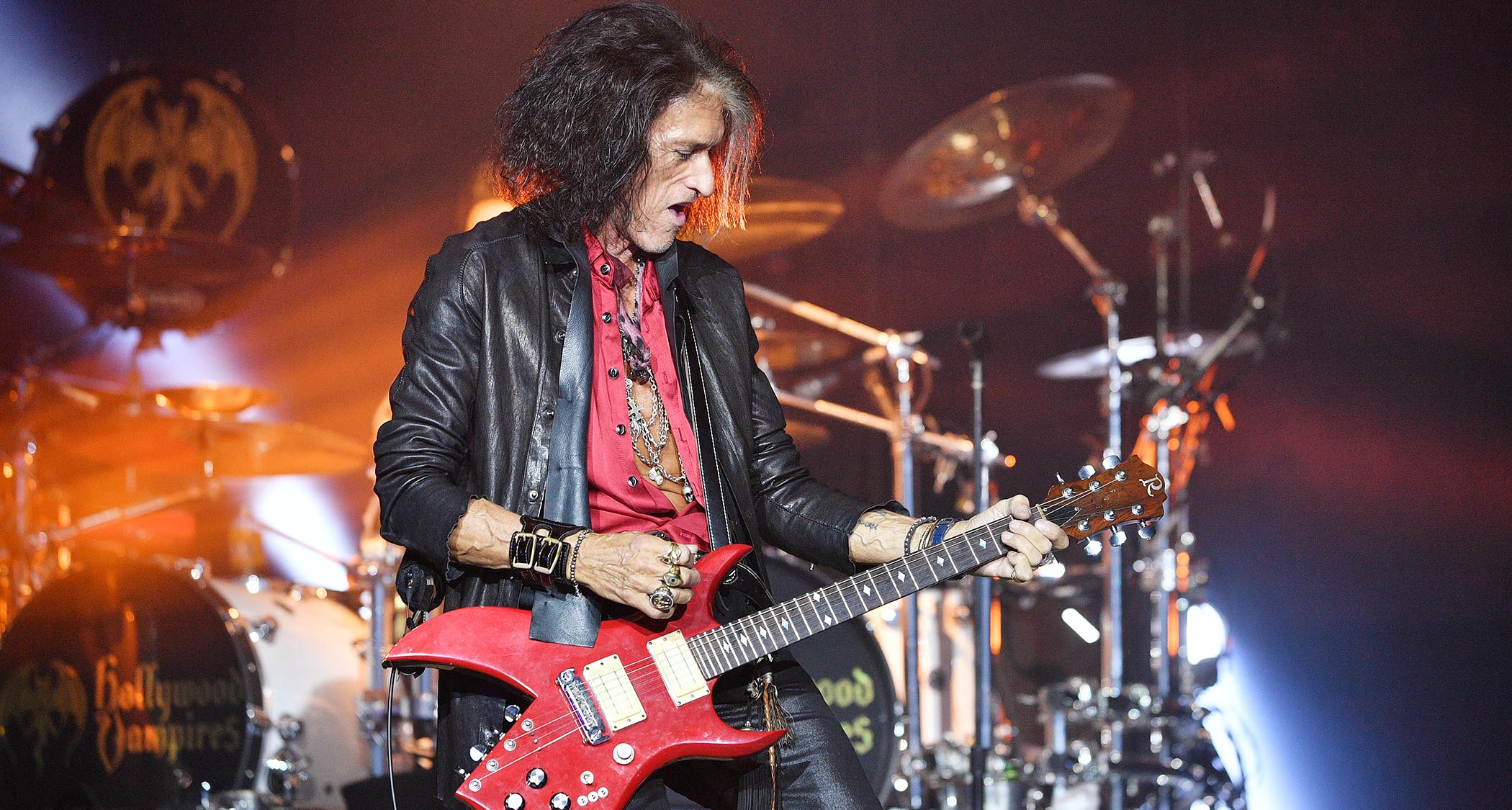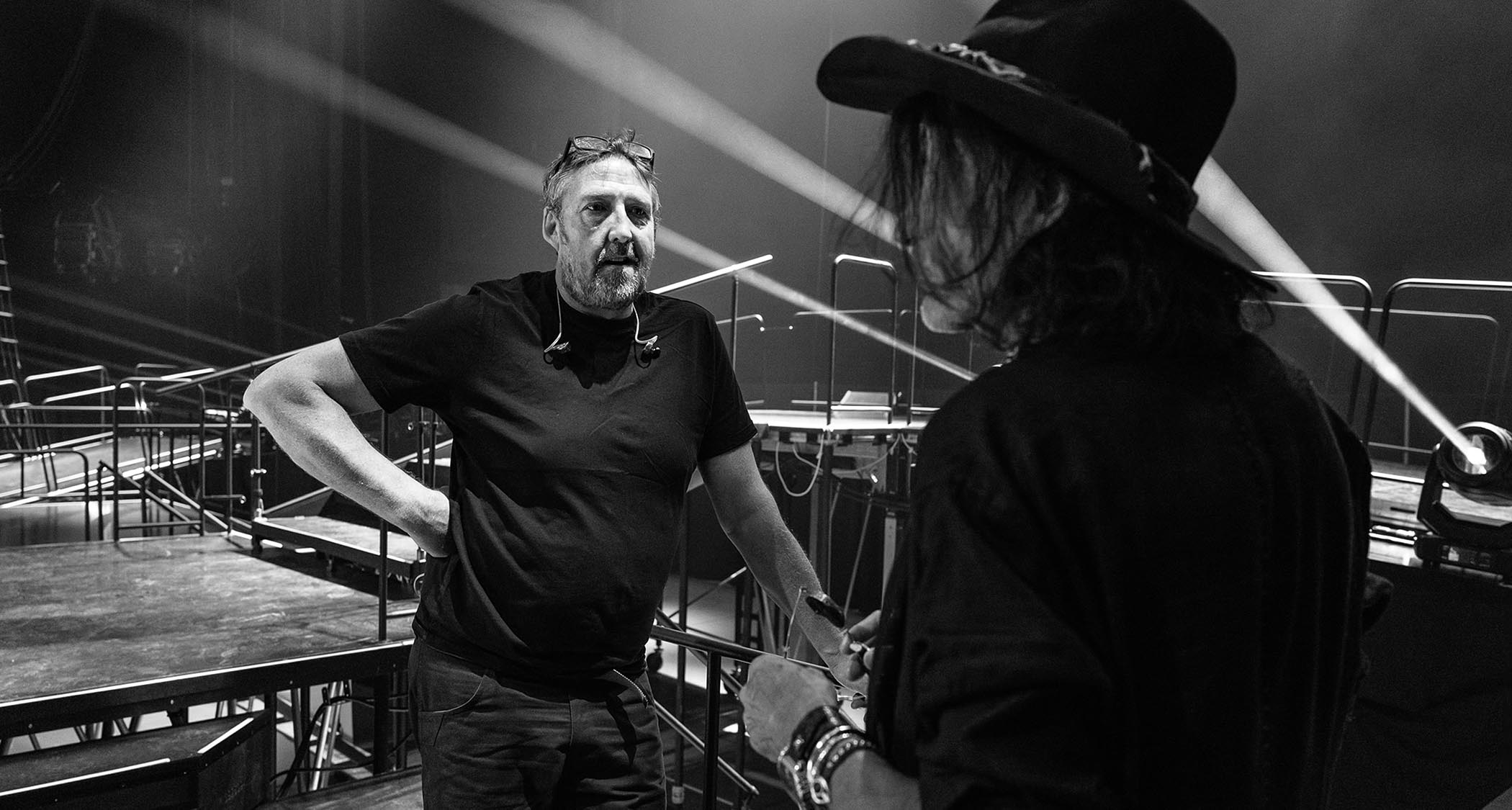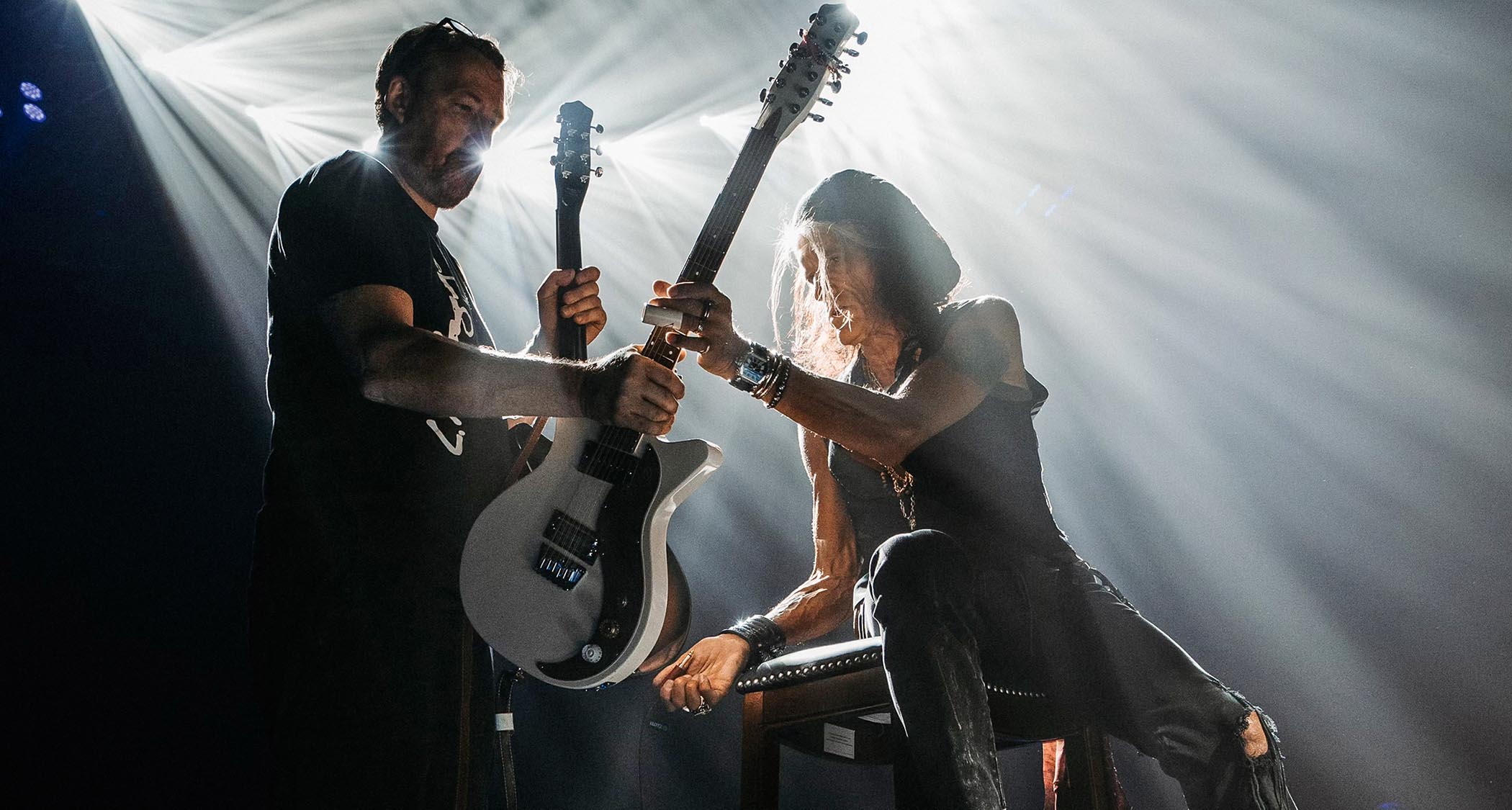“I can put an amp up and 10 minutes into the show it’ll be on fire. It’s just how Joe rolls”: The secrets behind Joe Perry’s awe-inspiring guitar rig by our man on the inside, guitar tech Darren Hurst
54 guitars. 8-gauge strings. A semi full of amps. Joe Perry's live rig is a changeable, often untameable beast, and Hurst has been in charge of it since 2019. With the Aerosmith juggernaut ready to pull in for good, he spills all of its secrets, from string gauge and intonation to a heck of a lot of gain stacking...

Darren Hurst had just finished five years’ work with Peter Frampton when he got the call to tech for Aerosmith’s Las Vegas residency in 2019. Since then, he’s become Joe Perry’s most trusted ally.
Joe enlisted Darren to catalog his 600-strong guitar collection, rebuild his rig, and join him for tours with Aerosmith, the Hollywood Vampires, and The Joe Perry Project. These are Darren’s top tips for sounding like Joe Perry…
Spontaneity is king
“It’s just like having a paint palette, but Joe never paints the song the same way twice. That is the thing I love most about working for him, but it’s also the most difficult. It’s cool, because it’s real, and it’s raw, and it’s alive. It centres around that edge of calamity.
“Sometimes it’s this beautiful, chaotic dance, where any minute it can fall off the rails, but it doesn’t. 95 times out of 100 it’s amazing. But you’ll get a night where something explodes and now you’re running around with your hair on fire, 10 minutes into a two-and-a-half-hour show!
“The setlist doesn’t come out till 20 minutes before the show, right when I’m tuning everything. I’ve got 54 guitars in five vaults – 24 I consider main show guitars, and two vaults of other things he can call for, and every guitar’s got a backup. Some days, he’ll just decide that he wants to lean on hollowbodies, or he wants to play Les Pauls. He’s been on a Strat kick recently. You never know which way he’s going to go.”

“He’ll lean in at the end of the song before and say, ‘Hey, I want to play that on the burnt Strat, or the Lucille or Billie.’ It can get a little hair-raising. Walk This Way is usually the silver Gretsch, although the last two shows, he wanted the burnt Strat. I’m also managing wireless for all these guitars. He could call for something that doesn’t have a pack on it, and then it’s a scramble.
“When I get to 4pm, I start to get nervous because I’m waiting for that text from Joe going, ‘Hey, let’s change out this pedal or that amp head!’ My soundcheck is already done, so anything we change at that point is wild and going into the show with no idea whether it works or not!”
Get The Pick Newsletter
All the latest guitar news, interviews, lessons, reviews, deals and more, direct to your inbox!
Turn the gain down and crank the volume
“Joe is always going to have a multi-amp rig. That’s part of the way his tone is created, because he’s not a high-gain player. His sound comes from clean boosts and it comes from volume. He likes low wattage heads with low wattage speakers. It still gets pretty loud on stage. Joe doesn’t play on in-ear monitors – he’s old-school.
I’ve got a Kemper in my rack. It does some amazing things, but it can’t sound like Joe Perry
“Right in front of Joe’s amp, it’s about 108 decibels. On the other side of the stage where Brad Whitford [guitar] and Tom Hamilton [bass] are, it’s silent because they’re on Kempers or something direct to the PA. We actually had to bring in a couple of Ampeg SVT stacks just to put some bass on stage, because Joe had nothing to play with.
“We were struggling because there just wasn’t any stage volume. It’s weird, because you watch the crowd – and this happens with a lot of bands – the first 10 rows just stand there with their arms folded, because there’s no electricity in the air. But on Joe’s side of the stage, you just get this natural movement, because there’s electrons and air movement. It just changes things.
“I know sound engineers love a silent stage, but screw those guys – rock ’n’ roll is supposed to move people! Even if you turn the backline around or you face a cab down, there’s got to be some kind of movement. I want the guitar to couple to the amp. I’ve got a Kemper in my rack. It does some amazing things, but it can’t sound like Joe Perry.”
Hit the guitar harder. No, HARDER!
“Joe is a very, very heavy hitter. I’ve been a Joe Perry fan for a long time – I mean, who hasn’t? But I didn’t know how great of a guitar player Joe was until I stood behind his amps and listened to him play at close quarters. For how hard he hits, the amount of control that he has is outstanding. He doesn’t hold back at all.
“When I first started working for him, he said, ‘I want you in the trenches with me, and we don’t phone it in.’ He goes 100 per cent every single night. If he’s tired, you still get 100 per cent. If he’s pissed off, you still get 100 per cent. And then there’s other nights where he just gives you 105 per cent.”
“There’s a video on YouTube of one of the Hollywood Vampires shows and he’s giving it everything he’s got. A JCM800 falls and whacks him on the shoulder. So many people were like, ‘That’s not a real head!’ That head was plugged in and working. There’s no faking it. I love that. It inspires you to work harder.
Joe plays a lot with his thumb, so naturally, he kinda pops on the upbeat. He’s almost got a stronger upbeat than he does downbeat
“The other thing that’s really interesting is when I play Joe’s rig at soundcheck, I don’t sound like Joe Perry. It’s Joe smacking the shit out of a guitar. It’s control, and it’s sheer velocity. Joe plays a lot with his thumb, so naturally, he kinda pops on the upbeat. He’s almost got a stronger upbeat than he does downbeat.
“If you listen to a lot of his riffs, they kind of pop in the spaces in between the downbeats. That’s what makes his riffs so funky. It’s unencumbered by anything else because everybody else in Aerosmith is playing on the downbeat, so he gets to have this space. Joe just weaves in and out of those pockets.”
Use light strings and a beefy action
“Joe likes thin strings. We went to 8s for the Hollywood Vampires shows. As we all get a little older, you want less tension. We also went to the Vega[-Trem] tremolo, which is a fully floating, medium spring.
“Aerosmith have a lot of cryo jets on stage. Those temperature changes can affect the guitar quite dramatically. If you’re any anywhere near a cryo jet and you’ve got 9s or 10s, those strings start to feel like steel bars until the guitar warms back up again. You’ve got to think about those kinds of things.
“For setups, he likes a little bit of fight. When you’ve got super-light strings, you’ve got to have something to grab hold of, so the necks have a little bit of relief. I’d say the action is about 3/32” (2.4mm) at the 10th fret, but I’m so used to just looking at it.
“I call it the Gary Moore setup. I want it to play super-easy at the nut, to be able to get hold of stuff at the high end, and to be able to dig in in the middle. But you can’t put too much relief in with Joe because he plays so hard, he will go sharp.”
“I don’t intonate Joe’s guitars at the 12th fret. I do compensated intonation, and that allows that extra bit of relief. Compensated intonation is to get all your open chords massively in tune.
“I intonate the high E and the B at the third fret, the G string at the eighth fret, the D string at the tenth fret, and then the A and the E at the 12th fret as usual. Your guitar is really in tune up to about the seventh or the eighth fret. Then it’ll start to drift a little bit, but with a little bit of finger pressure, you can put it in.
I do compensated intonation, and that allows that extra bit of relief. Compensated intonation is to get all your open chords massively in tune
“When Joe’s playing a solo, or he’s putting vibrato on a note, so when you get up to the 12th fret, if the notes are a little bit flat, the vibrato is going either side of the pitch anyway. That allows him to be super-solid in tune at the bottom and still have a little bit of air to grab hold on with such light strings. I learned that in Nashville. It’s great for recording, and it’s great if you use a capo because you put your guitar in tune with the capo.
“He hits the Vega-Trems pretty hard, and they do move because they’re not locking. We put locking tuners on them, and I grease the nuts every day. But we’re changing guitars nearly every other song, so the guitars don’t have to stay in tune very long. It helps that Joe doesn’t like new strings.”
More amps, please!
“We just talked about what amps we’ll use this year. He wants to do a couple of full stacks, maybe a half-stack with a slightly higher gain, and then the rest will be all combos. It’ll be a combination of probably Fender and Supro combos, although I’ve got a great new Ashdown combo to check out. The one great thing about working for Joe is it never stays the same.
“My favourite Joe Perry sound is a JCM800 with the Tube Screamer, and then something like either an Ampeg V4, or a Hiwatt Custom 50, and then a Fender combo. You combine those three things like a cake. You can front-end that with a little bit of gain stacking, a little boost, or a compressor if you want it super-clean.
“You could use a Klon, another TS9, or a fuzz pedal, and it’ll kind of hit everything, and then it all responds differently. It blends together beautifully. The Marshall is a little bit more ferocious. The Hiwatt is pure clean gain, and then the Fender’s kind of on the edge of breakup. If you stand 10 feet back from that, it’s Joe Perry.”
“On this tour we’ll also have an EVH 5150 combo and a 25 watt Hiwatt Custom they built for Joe, and that will be where we start. Whether that’s where we’ll stay I don’t know. He’s got so many friends that build amps and so many amps in this collection. I’ve got basically an entire semi truck devoted to Joe Perry’s gear. If he wants to change it up, I want to be able to give him what he wants.
“We go back and forth on Fender combos – Vibroverbs, Vibrolux. I like the way that they break up. I’ll take the Deluxe non-reverb out every single time, but the Fulltone tape echo seems to go into the Vibroverbs and Vibroluxes a little better. The Supros he’s got sound great. We use those out front.
“All those all those big Aerosmith hits were recorded on combos. The challenge for the tech is to make Joe Perry sound like Joe Perry when you’re traveling around 40 different arenas. I have to pinch myself some days when I wake up and there’s a whole bunch of gear that says 'Joe Perry' all over it!”
Gain staging: the tone secret of the pros
“With a Marshall, an Ibanez TS9 Tube Screamer is the secret for me. There’s a bunch of things out there that will do it – Boss OD-1 or SD-1, Origin Effects Halcyon, or any Klon clone. But my favorite is a TS9 into a JCM800. I get the JCM just on the verge of breakup. You find that little sweet spot where you hit a hit a chord and if you hit it too hard it goes like a pencil on a bottle: there’s a little ring that you get. You know, then just to dial a little hair back.
“Then I put a TS9 in front and it just stays on. It gain stages really, really well. You can put an OD-1 or a heavy metal pedal in front of it. If you’ve got a Marshall amp and you’re having trouble with it, just get a TS9 and just leave it on. Don’t even put it on your pedalboard. Just tape it to the back of the Marshall!
“In the rack, I’ve got an Origin Effects Revival Drive, another TS9, Joe’s main Klon, a Blues Driver, the MXR Micro Boost. I can gain-stage those five things in different combinations. Certain combinations work better than others. I don’t like a TS9 going into a Klon. It gets clumpy, but if you swap them around, the Klon can push the TS9, and it gets really singing.
“It’s kind of like a high gain amp – it’s got that little flutter, but you can get it at a much lower volume. Then you can punch in the Strymon Compadre compressor with the threshold on zero.
I don’t like a TS9 going into a Klon. It gets clumpy, but if you swap them around, the Klon can push the TS9, and it gets really singing
“I just use the Compadre’s boost to cascade into the Klon, which then cascades into the TS9. It’s controllable. You roll the volume down and it’s not hissing. You can leave the guitar wide open, take your hands off the guitar and doesn’t run away with itself. You’ve got everything in between if you’re the kind of player that rides your volume control, which Joe does.
“He’s typically set on eight and a half, and then he’ll open it up for a solo, and I might push in the boost on the compressor. Gain staging is about how things interplay with everything else.”
Get set up for slide

“On the Dan Armstrongs, you could put a pencil under the strings and it would probably fall out. They’re set up for slide. You ain’t playing chords on those guitars. They are .011 to .052, except there’s a unison on the bottom string [so Open A is A-A-E-A-C#-E]. The lowest string is a .060 from a bass set.
“The two As create this really interesting sitar-like drone. The slide will be on a slight angle, so the two notes beat against each other tuning‑wise. I love that sound, it’s really unique to Joe. Joe is such a good slide player. I’ve seen him play on the bus, really close up. He’s just monumental.”
Don’t fear hi-tech solutions
“Joe does embrace technology. We’re using an RJM Music Mastermind, a programmable multi-button MIDI interface that you can assign to anything. Joe has four of them on deck. Wherever he is on the stage, he can get to a wah pedal controller and a Whammy. It’s kind of cool because he’s got all this vintage stuff that he loves, but it’s all under modern control.”
Remember that guitars are just tools
“What I love about Joe is if we break it, he’s like, ‘Fuck it, we’ll get another one!’ With Joe, we use it till it blows up. Joe will say you change strings when they break. I’ve worked for players where you bias the tubes every day. That kind of appeals to one side of my brain because I love signal flow, but there’s another creative side of me that just loves the chaos.
“When we finish the show, the rigging guys descend on that thing like rats on a cadaver. The amps go into a road case still hot. This stuff gets abused. I can put an amp up and 10 minutes into the show it’ll be on fire. It’s just how Joe rolls: if it sounds good, it is good.
“He’s looking for an accident. He’s looking for a moment. He’s not looking for the same. He’s looking for an incident in time that creates something unique. I’m inspired by that.”
Jenna writes for Total Guitar and Guitar World, and is the former classic rock columnist for Guitar Techniques. She studied with Guthrie Govan at BIMM, and has taught guitar for 15 years. She's toured in 10 countries and played on a Top 10 album (in Sweden).
"A guitarist's ticket to easier home recording": PreSonus Quantum HD 2 review
“What blew me away was that everyone wanted the curly maple top. People were calling, saying, ‘I’ve got to have the bird inlays’”: Paul Reed Smith on raising the Standard 24, finally cracking the noise-free guitar and why John Sykes is a tone hero





















